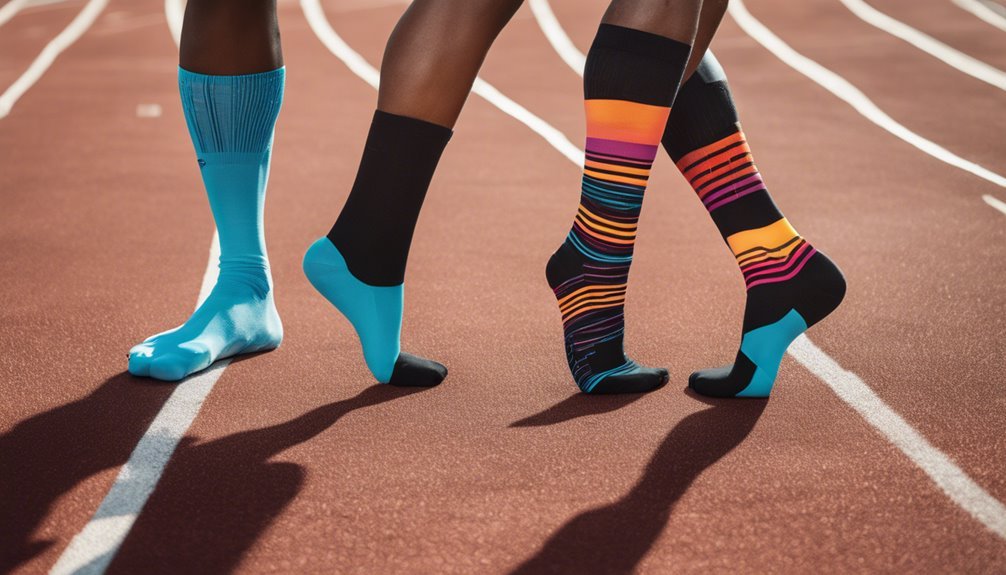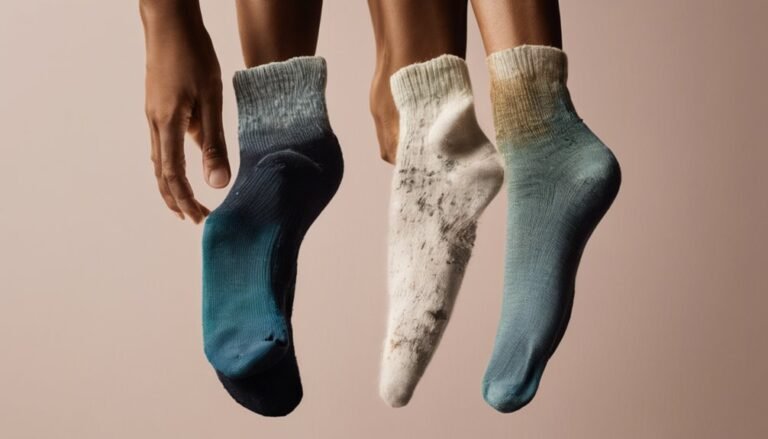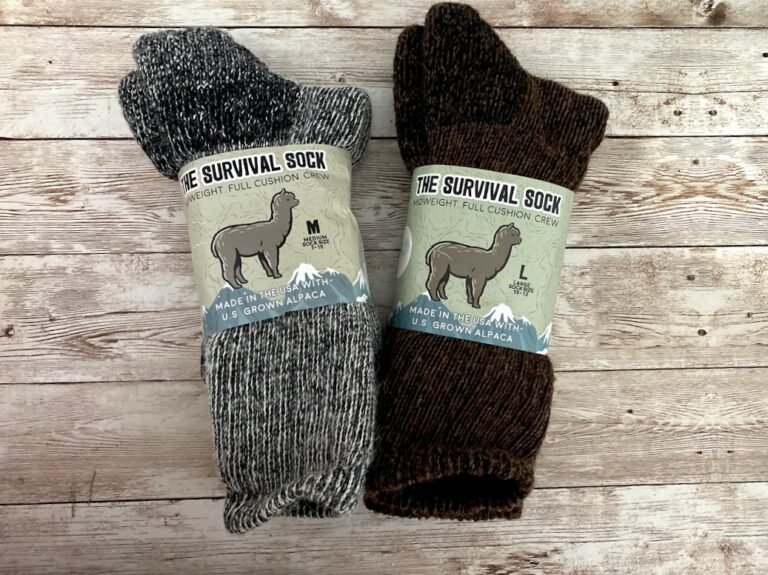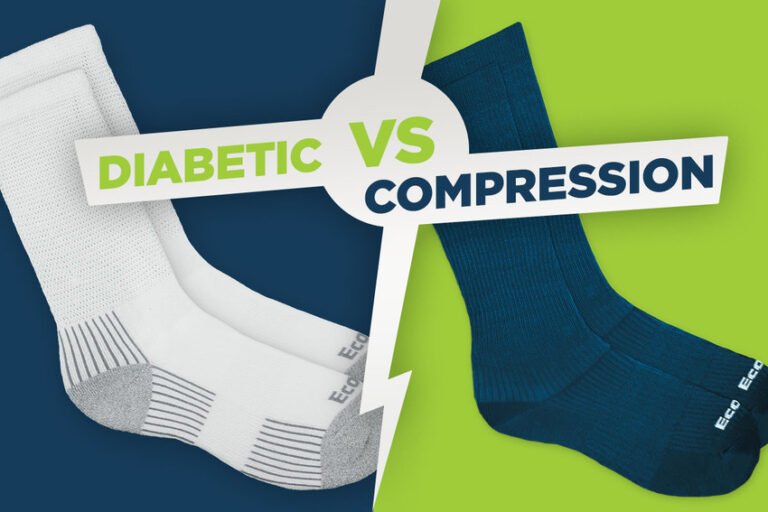Athletic Socks vs. Compression Socks: Which Is Best for Running?
When choosing between athletic and compression socks for running, consider your specific needs. Athletic socks focus on comfort and moisture management, using breathable materials to wick sweat away. In contrast, compression socks enhance blood circulation and reduce muscle fatigue with tighter, elastic designs. If you're after comfort for casual runs, athletic socks may be best. However, for longer distances, compression socks can improve performance and recovery. Explore further to discover how to make the best choice for your runs.
Understanding Athletic Socks

Athletic socks play an essential role in enhancing your running experience by providing comfort and support. The choice of sock materials is vital; synthetic fibers like polyester and nylon excel in moisture management, effectively wicking sweat away from your skin. This feature helps prevent blisters, discomfort, and the dreaded soggy sock feeling during your runs. Additionally, cushioned areas in athletic socks absorb impact, offering enhanced support for your arches and heels. You'll find that the right socks can reduce fatigue, allowing you to run longer and more freely. Ultimately, investing in high-quality athletic socks tailored to your needs will greatly boost your performance, providing a foundation of comfort that complements your running journey.
Benefits of Compression Socks
When you wear compression socks, you'll notice enhanced blood circulation, which can greatly improve your running performance. Studies indicate that improved circulation not only aids in quicker recovery but also reduces muscle fatigue during and after your runs. By incorporating these socks into your routine, you're likely to experience less soreness and a more efficient workout overall.
Enhanced Blood Circulation
While many runners focus on comfort and moisture-wicking properties in their sock choices, the benefits of compression socks extend far beyond basic functionality, particularly in enhancing blood circulation. The sock design of compression socks is specifically engineered to apply graduated pressure, which promotes increased blood flow to your muscles. This enhanced circulation can lead to improved oxygen delivery, enabling you to perform better during your runs. Studies indicate that better blood flow can also aid in the removal of metabolic waste products, further supporting your endurance. By choosing compression socks, you're not just opting for a tighter fit; you're investing in a tool that optimizes your body's performance, giving you the freedom to push your limits with each stride.
Reduced Muscle Fatigue
Muscle fatigue can markedly hinder your running performance, but compression socks offer a viable solution to this common issue. By applying graduated pressure to your lower legs, these socks enhance blood circulation, which directly contributes to improved muscle recovery. Research shows that compression garments can reduce the onset of soreness and fatigue, enabling you to maintain your pace longer. This performance enhancement is essential, especially during prolonged runs or races. The compression helps support muscle stability, minimizing vibrations that lead to fatigue. As a result, you'll experience less discomfort and quicker recovery times, allowing you to enjoy your runs with a sense of freedom and endurance. Embracing compression socks could be the key to releasing your full running potential.
Key Differences Between Athletic and Compression Socks
Understanding the key differences between athletic socks and compression socks can greatly impact your running performance and recovery. Here are three critical aspects to reflect upon:
- Materials Used: Athletic socks typically feature moisture-wicking fabrics for comfort, while compression socks often use tighter, elastic materials that promote blood circulation.
- Sizing Options: Athletic socks come in various sizes to fit your foot snugly, whereas compression socks focus more on graduated sizing for peak compression around the calf and ankle.
- Functionality: Athletic socks prioritize comfort and cushioning, while compression socks aim to enhance blood flow, reducing muscle fatigue during and after runs.
Choosing the right type can enhance your freedom of movement and overall running experience, allowing you to push your limits confidently.
When to Use Athletic Socks
When you're gearing up for a run, selecting the right athletic socks can greatly influence your performance and comfort. Choose socks made from breathable sock materials like merino wool or synthetic blends, as they enhance moisture management. Effective moisture control helps prevent blisters and keeps your feet dry, allowing for longer, more enjoyable runs. If you're running in warmer conditions, lightweight, moisture-wicking socks can keep your feet cool and reduce sweat buildup. Conversely, in cooler weather, thicker socks can provide insulation while still managing moisture effectively. Always consider the terrain too; cushioned socks may be beneficial for trail running, while lightweight options work well for road runs. Making these informed choices guarantees you enjoy the freedom of movement and comfort during your runs.
When to Use Compression Socks

How can compression socks enhance your running experience? These specialized socks offer significant advantages when you're looking to maximize performance and well-being. Consider using them in the following scenarios:
- Post-Run Recovery: They improve blood circulation, which aids in faster recovery benefits.
- Long-Distance Runs: Wearing compression socks during prolonged runs can help with injury prevention by stabilizing your muscles and reducing fatigue.
- Traveling or Rest Days: If you're sitting for long periods, they prevent swelling and maintain blood flow.
Incorporating compression socks into your routine not only enhances your comfort but also supports your body's natural recovery processes. With the right approach, you can truly experience the freedom of running without the burden of injuries or prolonged fatigue.
Choosing the Right Sock for Your Running Needs
Which type of sock best suits your running needs? When choosing, consider sock materials and running terrain. For trail running, look for socks with moisture-wicking fabrics like merino wool or synthetic blends, which offer durability and comfort against rough surfaces. If you're on pavement, lightweight polyester or nylon socks might be best for breathability and a snug fit. Compression socks can enhance circulation, making them a solid choice for longer distances or recovery runs. Additionally, consider cushioning levels based on your comfort preferences and the terrain's impact. Ultimately, the right sock balances support and flexibility, allowing you to focus on your run without the distraction of discomfort. Tailor your choice to your unique running style for the best experience.
Frequently Asked Questions
Can I Wear Compression Socks All Day After Running?
Imagine your legs wrapped in gentle support, easing fatigue. You can wear compression socks all day after running; their compression benefits promote circulation and recovery, making them ideal for daily wear without discomfort. Enjoy that freedom!
How Do I Know My Sock Size?
To determine your sock size, measure your foot length and refer to a size chart. Accurate sock measurement guarantees ideal comfort and performance, allowing you to enjoy unrestricted movement during any activity you choose.
Do Socks Really Affect Running Performance?
When you lace up and hit the pavement, sock technology plays a pivotal role; it can enhance comfort and stability. The right socks can indeed offer performance benefits, reducing fatigue and improving your running experience.
Are There Specific Brands Recommended for Each Type?
When choosing sock brands, look for those known for their quality and performance. Compression socks can enhance circulation, so brands like CEP or Zensah offer significant compression benefits, while others excel in moisture-wicking athletic designs.
Can I Use Compression Socks for Recovery After Other Workouts?
Absolutely, you can enjoy the soothing compression benefits for recovery after workouts. Incorporating compression socks into your recovery strategies can enhance circulation and reduce soreness, making your post-exercise routine feel like a gentle embrace for your legs.







